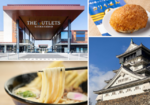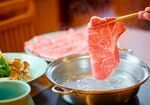Opened in January 2024, the Sousaku Kushiage Tsuda Toranomon Hills Station restaurant is owned by Takeshi Tsuda, who trained at the famous Osaka Kushikatsu restaurant Rokukakutei and operates two other locations in his native Aichi. This restaurant offers a sublime combination of top-quality ingredients, creating dishes that are both visually stunning and rich in flavor. Each skewer is crafted with lavish care, delivering a dish that evokes a sense of wonder. This report covers the '11 Types of Skewers Course' (6,500 yen), experienced in mid-August, highlighting the surprisingly light yet captivating allure of the fried skewers, accompanied by Mr. Tsuda's detailed explanations.
Experience the taste of Nagoya's popular Kushiage restaurant in Toranomon, Tokyo.
![Experience the taste of Nagoya's popular kushikatsu restaurant, now available in Toranomon, Tokyo.]()
![The popular Nagoya restaurant, [Creative Kushikatsu Tsuda], makes its first appearance in Tokyo! Explore the allure of the light yet lavish "Tsuda-style" kushikatsu at Toranomon Hills.]()
The restaurant, Sousaku Kushiage Tsuda Toranomon Hills Station restaurant, is located on the fourth floor, a level known for its collection of renowned restaurants. Upon entering, one is immediately greeted by the dazzling art of wisteria flowers. Beyond the windows, a grand view of the Tokyo Tower unfolds. 'In Nagoya, following our main branch, we have a restaurant next to the East Gate of Nagoya Castle in Kinshachi Yokocho. Thus, the interior design in Tokyo is inspired by Nagoya Castle. The walls represent the castle's fortifications, and the wisteria art is inspired by the wisteria trellises in Meijo Park,' explains Mr. Tsuda, the owner.
The wisteria paintings were hand-painted directly here. Among the eateries on the fourth floor of Toranomon Hills Station Tower, only a limited number have such a clear view of the Tokyo Tower. Whether for a date or a business meal, bringing someone here is sure to delight them.
![The popular Nagoya restaurant, [Creative Kushikatsu Tsuda], makes its first appearance in Tokyo! Explore the allure of the light yet lavish "Tsuda-style" kushikatsu at Toranomon Hills.]()
When asked about the secret to the deliciousness while standing in front of the frying area inside the counter, Mr. Tsuda laughs and says, 'I'm just doing what the master from Rokukakutei taught me,' but he also kindly explained the secrets behind the surprisingly light Kushiage and the exquisite sauce. Let us introduce the course we experienced along with the 'Tsuda-style' commitment.
Experience the '11 Types of Skewers Course' along with recommended Sake
Initially, sticks of radish and carrot, cherry tomatoes, cabbage, and lotus root chips are placed on the table along with five types of sauces. These are used as a palate cleanser before the first skewer arrives and between skewers, where guests can dip them in their sauce of choice. From the right, the sauces include 'Sansho Salt' made with sun-dried salt from Okinawa and Sansho pepper from Kyoto, a 'Special Sauce' made from over 30 ingredients including ginseng and turmeric and various Chinese herbs, 'Homemade Soy Sauce' in the center, a 'Tokyo Exclusive Sauce' based on the special sauce with added sesame and mustard, and a simple 'Mustard and Lemon' sauce.
'The special sauce is prepared in a large pot over more than three days. Depending on the season, we adjust the flavor profile, making it tangy in spring, spicy in summer, and gradually milder from autumn,' says Mr. Tsuda.
First skewer: 'Live tiger prawn'
The first dish served is 'Live tiger prawn'. According to Mr. Tsuda, 'It's a single piece that serves as a business card representing its freshness.' Until just before it is served, the prawn is kept in lemon water and chilled with ice. It is enjoyed with Sansho salt and lemon, and the careful attention to ensure no seeds fall from the lemon is indeed impressive. Upon tasting, the firm texture and distinct flavor of the prawn unfold in your mouth. Incidentally, the prawn is served on crackers made from rye and bran.
Second skewer: 'Omi Beef Tomosankaku'
Next up is the skewered deep-fried Omi beef Tomosankaku. Ingredients that tend to release juices, such as meat, are first coated with a firm batter before being dipped into a softer one. 'Typical skewered deep-fried batter consists only of water and flour, but by adding meringue and milk, it achieves a gentle texture on the palate.' Very fine breadcrumbs are used. When dipped in a special sauce, the Umami of the meat and sauce bursts forth, providing a satisfaction akin to a main dish by the second skewer.
Third skewer: 'Scallop from Aomori Prefecture'
The scallop adductor muscles paired with the recommended wine, a New Zealand 'Stratum Pinot Gris' (1,300 yen per glass), are notable for their mild acidity and fruitiness. It is said that the batter used for coating includes white wine, which explains why the wine pairs so seamlessly. The restaurant also features wines from 'KENZO ESTATE'.
Fourth skewer: 'Green Peas Croquette'
The fifth skewer: 'Local Chicken with Perilla Leaves and Tonburi'
The pea croquettes are piping hot and fluffy as soon as they hit your mouth. The natural flavors of the ingredients are tightly sealed in, and enhanced by the heat. When they are served right in front of you, you'll want to gobble them up while they're still hot, but be careful not to burn yourself (laughs).
The chicken of the day uses Mikawa chicken from Aichi Prefecture. It's prepared refreshingly with perilla leaves, and generously topped with Akita Prefecture's Tonburi for a fun texture. 'The skewers are placed according to the direction of the dipping sauce, so even if you're chatting, you can just look and be fine. Regular customers enjoy explaining this to first-timers they bring along,' says Mr. Tsuda.
Sixth skewer: 'Matsutake'
Matsutake mushrooms can be enjoyed in two parts, the cap and the stem, on a single skewer. For an autumn delicacy, they are paired with Sake. We were served 'Ubusuna' (glass priced at 1,300 yen), brewed by Hananoka Shuzo in Kumamoto Prefecture using Yamadanishiki rice. 'It's a slightly sparkling sake with nuances of peach and yogurt,' says Manager Hideki Kunimatsu. The sake selection is carefully curated through tastings by Mr. Tsuda, Mr. Kunimatsu, and six others.
Seventh skewer: 'Crab Cream Croquette'
The seventh skewer features a creamy crab cream croquette made with genuine snow crab. It also contains crab miso, offering a deep flavor in each skewer. From the counter seats, one can clearly see the frying area, but since it is fried slowly at 170°C, hardly any noise is heard. Once frying is completed, the skewer is rotated to drain the oil before serving. This extra step results in a lighter texture and a refreshingly light aftertaste. Many elderly regulars say, 'Mr. Tsuda's kushikatsu doesn't leave you feeling heavy the next day.' The frying oil, a carefully managed blend of lard and vegetable oils, achieves a light and fragrant golden-brown coating.
Eighth skewer: 'Komochi Konbu'
Ninth skewer: 'Ginkgo'
The crunchy child-bearing kelp is enjoyed with mixed soy sauce. It seems to enhance the flavor many times more than when eaten as is. This skewer is highly recommended by Manager Mr. Kunimatsu.
Ginkgo nuts are carefully selected from the famous producing area of Sobue in Aichi Prefecture, in a splendid 3L size, and are served coated with Karasumi. In line with the desire to 'show the natural form of the ingredients as much as possible,' the ginkgo nuts are presented in a charming visual, peeking out of the batter, a unique touch found here.
10th skewer: 'Hamo and Cream Cheese'
11th skewer: 'Salmon with Hokkaido Salmon Roe'
![11th skewer: 'Salmon with Hokkaido Salmon Roe']()
The skewer wrapped with cream cheese and hamo (pike conger) from Awaji is accompanied by a sweet plum paste with subdued acidity, making it a perfect match with the cream cheese. It offers a blend of Japanese and Western tastes, pairing well with both sake and wine. 'It would be nice to have both a wine glass and a sake glass at hand to enjoy,' says Mr. Kunimatsu, 'There are regulars who line up glasses of both white and red wine,' he adds. 'You might think to pair it with white wine since it's seafood, but red wine also goes well because of the added oil,' explains Mr. Tsuda.
The last, 11th skewer is the signature 'parent and child skewer' of salmon and Ikura. The generously topped Ikura is large and lustrous. It has been prepared by a fishmonger in Nagoya with whom they have had a relationship for 11 years. It has been offered since before the era of Instagram, and it truly makes for a photogenic skewer. Once tasted, the luxurious flavor is absolutely enchanting.
Fried Rice Cracker Tea Rice
![Fried Rice Cracker Tea Rice]()
Rice sprinkled with arare (rice crackers) is pulled from the skewer and served with a refined-flavored dashi poured over it. As it gradually crumbles, adding Wasabi and Tsukudani lined up in front can change the taste. This dish was originally a secret menu item enjoyed by Mr. Tsuda's mother when she visited the restaurant, and due to other guests' requests to try it, it became an official menu item about seven years ago.
'Having rice at the end of the course is comforting, isn't it? I'm a food lover, so I serve what I want to eat to my customers as well,' says Mr. Tsuda. We look forward to the new dishes he will create in the future. The meal was concluded with crème brûlée for dessert and coffee afterwards. Thank you for the wonderful meal!
The variety and the ability to feel the seasonality exceeded expectations at Sousaku Kushiage Tsuda, with its Kushiage (deep-fried skewers). In the upcoming season, items such as chestnuts cooked with brandy and black sugar syrup (sounds delicious just hearing about it!), oysters marinated in champagne, pufferfish, and milt are expected to appear. While the course is recommended for first-timers, ordering à la carte based on personal preference might be a good option for subsequent visits. It's a restaurant worth visiting each season.
Sousaku Kushiage Tsuda Toranomon Hills Station Ten
Open:
[Monday, Tuesday, Thursday-Sunday, National Holidays, Day Before National Holidays] Lunch 11:00 am - 2:30 pm (L.O. 2:00 pm) / [Monday, Tuesday, Thursday-Saturday, Day Before National Holidays] Dinner 5:00 pm - 11:00 pm (L.O. 10:00 pm) / [Sunday, National Holidays] Dinner 5:00 pm - 10:00 pm (L.O. 9:00 pm)Closed:
WednesdayAverage price:
[Dinner] 10,000 JPY / [Lunch] 2,500 JPYAccess:
Direct access to Toranomon Hills Station on the Tokyo Metro Hibiya Line, located on the 4th floor / 8-minute walk from Toranomon Station on the Tokyo Metro Ginza LineAddress:
4F, Toranomon Hills Station Tower, 2-6-3, Toranomon, Minato-ku, Tokyo More Details Reservation Disclaimer: All information is accurate at time of publication.
![The popular Nagoya restaurant, [Sousaku Kushiage Tsuda], makes its first appearance in Tokyo! Explore the allure of the light yet lavish](/gg/content_image/MM_4296.jpg)

![The popular Nagoya restaurant, [Creative Kushikatsu Tsuda], makes its first appearance in Tokyo! Explore the allure of the light yet lavish "Tsuda-style" kushikatsu at Toranomon Hills.](/gg/content_image/MC_4296_142088_1.jpg)
![The popular Nagoya restaurant, [Creative Kushikatsu Tsuda], makes its first appearance in Tokyo! Explore the allure of the light yet lavish "Tsuda-style" kushikatsu at Toranomon Hills.](/gg/content_image/MC_4296_142090_1.jpg)

![The popular Nagoya restaurant, [Creative Kushikatsu Tsuda], makes its first appearance in Tokyo! Explore the allure of the light yet lavish "Tsuda-style" kushikatsu at Toranomon Hills.](/gg/content_image/MC_4296_142093_2.jpg)


![The popular Nagoya restaurant, [Creative Kushikatsu Tsuda], makes its first appearance in Tokyo! Explore the allure of the light yet lavish "Tsuda-style" kushikatsu at Toranomon Hills.](/gg/content_image/MC_4296_142100_1.jpg)





![The popular Nagoya restaurant, [Creative Kushikatsu Tsuda], makes its first appearance in Tokyo! Explore the allure of the light yet lavish "Tsuda-style" kushikatsu at Toranomon Hills.](/gg/content_image/MC_4296_142115_1.jpg)











![[2023 Edition] What Is the Difference Between Kappo and Ryotei? A Look Into the Deep World of Japanese Cuisine](/gg/content_image/tn0013_001_150x105z.jpg)












